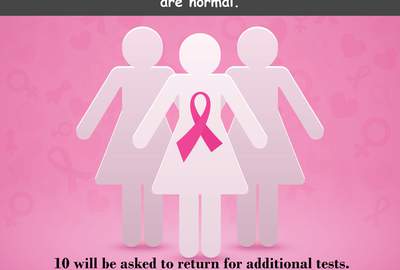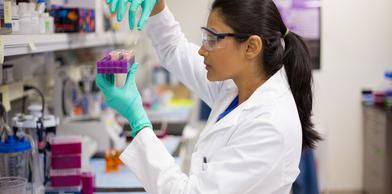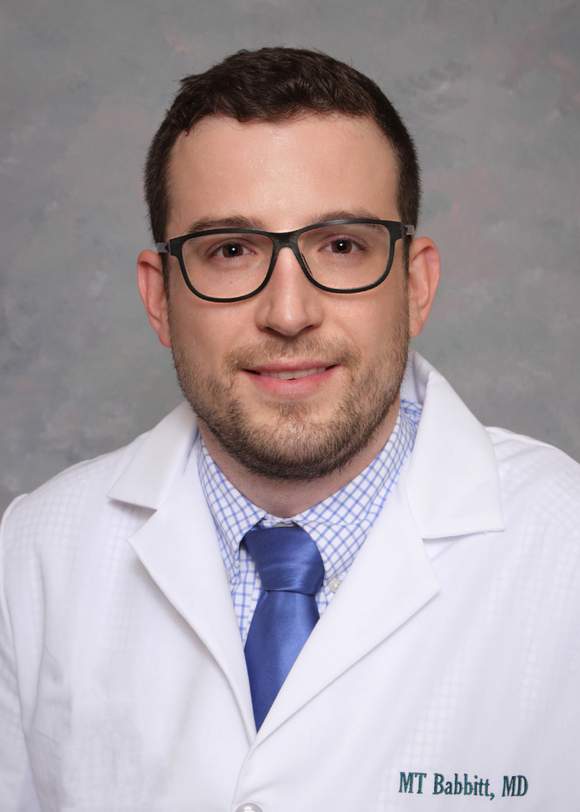
MICHAEL BABBITT, M.D. RADIOLOGIST
Think about this: Ninety-nine of every one-hundred women diagnosed with breast cancer in its earliest stages will live at least five years.
The key to their survival is this simple: early detection.
“I can’t say enough about the importance of early detection,” says Dr. Michael Babbitt, M.D., a radiologist who is certified under the Mammography Quality Standards Act (MQSA) and has training and experience in breast imaging.
“I found this statistic the other day: there are roughly four million Americans alive today who are breast cancer survivors in large part due to early detection,” Dr. Babbitt says. “Breast cancer treatment is getting better and better. Over the last thirty or forty years, we’ve made a lot of advances in surgery, radiation, immunotherapies, novel combinations of chemotherapy drugs, and other approaches. Without a doubt, the best thing we can do for a patient with breast cancer is to detect it as early as possible. It is much preferred to detect cancer before a patient develops a lump in their breast that they can feel,” Dr. Babbitt says. “Early diagnosis enables early treatment which results in better outcomes.”
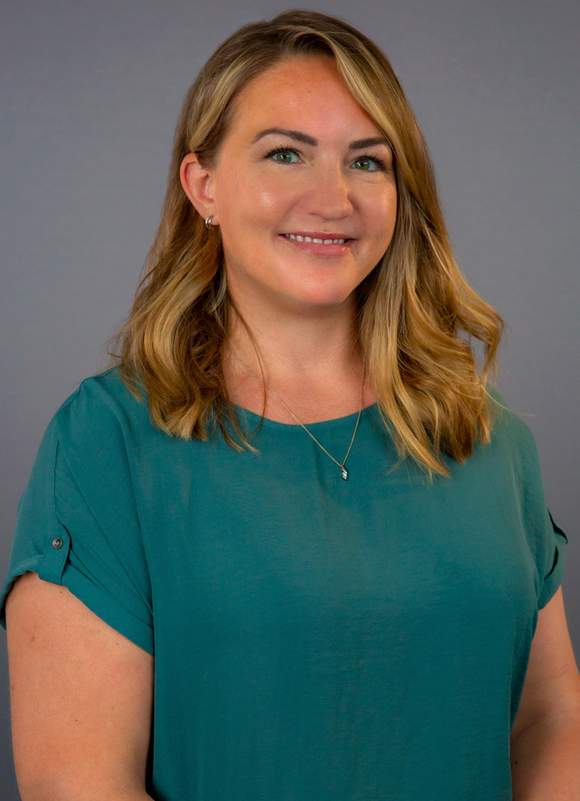
CAROLYN RUBY, DIRECTOR OF IMAGING SERVICES
Early detection comes from regular breast screenings. “Often, patients don't even know they have breast cancer until their annual screening,” says Carolyn Ruby, Director of Imaging Services at Froedtert South. “It’s very important to start getting annual mammography screenings in your early forties.”
“Some patients should start regular breast screenings earlier than forty if they’re at high risk for breast cancer due to a family history of the disease or other factors identified by their physicians,” Dr. Babbitt says. “Consistent annual screening is the most important thing you can do, because we are here to detect it early, and this gives us the best chance for treating it once detected.”
“We perform regular screening mammograms on patients using our advanced 3D imaging machines,” Ruby says. “Our radiologists then compare a patient’s current mammography images with previous ones to look for changes or abnormalities in their breast tissue that may warrant further investigation.”
“Breast cancer doesn't always grow really fast; it can grow very slowly,” says Kathy Lashley, a mammographer at Froedtert South. “If there are changes, we want to know earlier rather than later.”
“We also see patients who have discovered a lump, or have breast pain or other issues with their breasts,” Dr. Babbitt says. “We evaluate these patients with a diagnostic work-up that often includes diagnostic mammogram as well as ultrasound, sometimes MRI, and biopsy, if necessary. By using multiple diagnostic tools, including advanced imaging techniques, we have a high success rate with detection and diagnosis.”
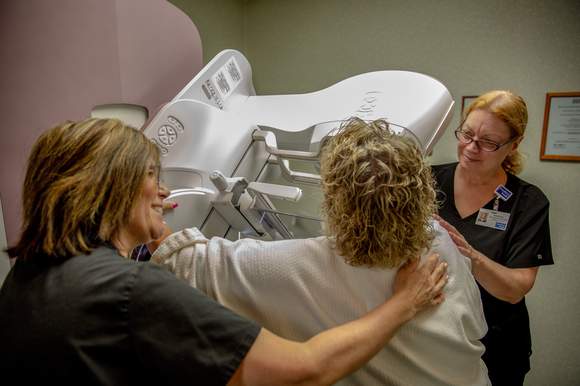
Kathy Lashley, a Mammographer Technologist at Froedtert South, performs a routine mammogram for a female patient.
“We want to perform a diagnostic mammogram as soon as possible after a patient finds a lump in their breast,” says Lashley. “Also, if we find a change in a patient’s screening images, we bring them back for diagnostic imaging as soon as possible to investigate what’s changed.”
“Some patients coming in for their first mammogram are afraid that we're going to hurt them,” says Lashley. “The first thing we want them to know is that this exam is very easy. It's a little uncomfortable, but not painful. After the first one, patients are often surprised by how easy the test was. I want women to know they have nothing to fear.”
“To obtain top quality images, we have to compress the breast,” Dr. Babbitt says. “Compression limits imperfections in the image caused by motion, and allows us to take the high-resolution images that help us detect changes. We try to minimize the discomfort by how our technologists position the patient.”
“The mammogram image is taken so quickly that a patient isn’t held in an uncomfortable position for very long at all,” says Ruby. “We can capture four images in about five minutes,” adds Lashley.
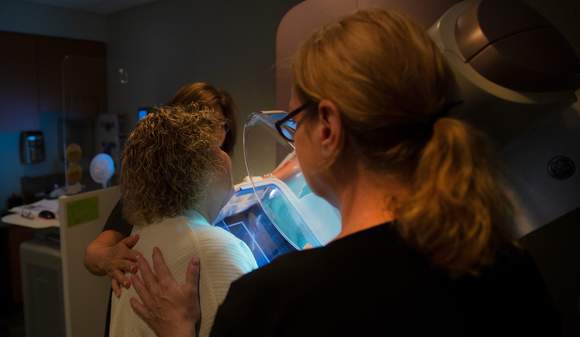
“Sadly, fear of the unknown discourages some women from getting regular breast cancer screening,” says Ruby. “As a patient myself, I know that having a mammogram can make anyone feel apprehensive because of the potential results. We’re working to break those walls down because early detection is so essential.”
“Our staff is also dedicated to maintaining the privacy of each patient undergoing a mammogram,” says Ruby, “treating patients with respect, and making sure they understand every step in the process.”
“We are listeners here,” says Dr. Babbitt, “and work hard to provide patients with the information they need to make their own decisions. We give patients our best advice, but we also like to listen to each individual patient to make sure they are involved in their care and have all their questions answered. We strive to offer individualized patient care according to each patient’s needs.”
“Our mission is to provide the best care to our patients by obtaining the highest quality breast imaging to assist in their diagnosis and treatment,” says Ruby.
“Women thank us all the time for finding their breast cancer, or their mother’s, or aunt’s, or daughter’s breast cancer,” says Lashley. “We hear those stories all the time.”
“Helping people provides our team with a lot of satisfaction,” says Dr. Babbitt. “Any time we detect a very small breast cancer, that is exciting for us. We don't ever like to see breast cancer, but when we detect it early at a small size, we know this means better outcomes. That is not to say that a late detected breast cancer is not treatable. At Froedtert South, we have an expert multidisciplinary team of physicians in surgery, oncology, and radiation oncology who are excellent in providing individualized treatment to maximize success for patients.”
Breast cancer by the numbers
According to the American Cancer Society:
- Nearly 298,000 new cases of invasive breast cancer will be diagnosed in U.S. women in 2023
- Breast cancer mainly occurs in middle-aged and older women
- But half of women with breast cancer were diagnosed when they were sixty-two years old or younger
- One in eight women will develop breast cancer – meaning that seven in eight won’t
- Breast cancer is the second leading cause of cancer death among women – exceeded only by lung cancer
- Breast cancer death rates have been declining since 1989
- Early detection through regular breast screenings is believed to be the reason for the decline in death rates
